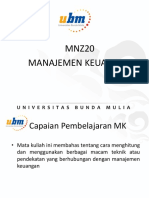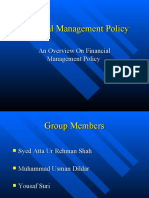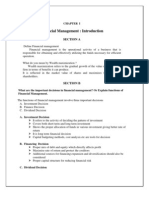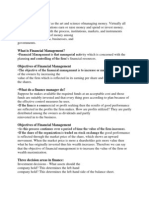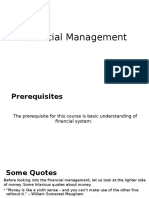0 ratings0% found this document useful (0 votes)
73 viewsChapter 1-FM
The document provides an overview of finance and financial management. It discusses key topics such as:
1) The definition and scope of finance, including private and public finance.
2) The objectives, scope, and decisions involved in financial management, such as investment, financing, dividend, and working capital decisions.
3) Related concepts like the agency problem that can arise between managers and shareholders, and the sources and costs of addressing this problem.
Uploaded by
bereket nigussieCopyright
© © All Rights Reserved
Available Formats
Download as PDF, TXT or read online on Scribd
0 ratings0% found this document useful (0 votes)
73 viewsChapter 1-FM
The document provides an overview of finance and financial management. It discusses key topics such as:
1) The definition and scope of finance, including private and public finance.
2) The objectives, scope, and decisions involved in financial management, such as investment, financing, dividend, and working capital decisions.
3) Related concepts like the agency problem that can arise between managers and shareholders, and the sources and costs of addressing this problem.
Uploaded by
bereket nigussieCopyright
© © All Rights Reserved
Available Formats
Download as PDF, TXT or read online on Scribd
You are on page 1/ 20
Chapter 1: Introduction
•Finance may be defined as the art and science
of managing money.
•Finance also is referred as the provision of
money at the time when it is needed.
•The finance function is the procurement of
funds and their effective utilization in business
concerns.
TYPES OF FINANCE
• Private Finance, which includes the Individual, Firms,
Business or Corporate Financial activities to meet the
requirements.
• Public Finance which concerns with revenue and
disbursement of Government.
Similarities and Differences between Public Finance
and Private Finance
Similarities
• Based on Similar Theories of Maximization - wants to secure
maximum utility on count of minimum expenditure
• Both Face the Problem of Scarcity
• Both Require Efficient Administration - to look after the
various acts of extravagance.
• Both Borrow and Must Repay
Differences
• Individual determines his expenditure on the basis of his
income but government determines its income on the basis of
its expenditure.
• Government’s source of income is more flexible in comparison
to private source.
• It is easy for an individual to base his expenditure on the law
of equal marginal utility, but far difficult for governments.
• Private finance is narrow and short lived in comparison to
public finance.
• Public finance is subject to public censor but not the private
finance.
Differences
• There is difference in the budgeting process of the
public finance and the private finance.
• Governments’ accounts are audited by constitutional
authorities but private finance has its own
arrangement.
• A private individual can face the crises of being
bankrupt but no government can be bankrupt.
What is Financial Management?
•It is concerned with how much and what types
of assets to acquire, how to raise the capital
needed to buy assets, and how to run the firm
so as to maximize its value.
Scope of Financial Management
Investment Decisions
• It is about spending capital on assets that will yield the highest
return for the company over a desired time period.
• The investment must meet three main criteria:
It must maximize the value of the firm, after considering
the amount of risk the company is comfortable with.
It must be financed appropriately.
If there is no investment opportunity that fills (1) and (2),
the cash must be returned to shareholder in order to
maximize shareholder value.
Financing Decisions
• It is the financing decision process that determines the optimal way to
finance the investment.
• There are two ways to finance an investment: using a company’s own
money or by raising from external funds.
• Financing decisions for example:
Whether to use external borrowings/debts or capital or retained
earnings
Whether to borrow short, medium or long term
What sort of mix – all borrowings or part debts part share capital
or 100% share capital
The needs to determine how much dividend to pay out as this will
affect the financial decision
Dividend Decision
• Refers to that part of profits of a company which is distributed
by it among its shareholders.
• To take dividend decision finance manager keeps in mind the
growth plans and investment opportunities.
If more investment opportunities are available and company
has growth plans then more is kept aside as retained
earnings and less is given in the form of dividend,
if company wants to satisfy its shareholders and has less
growth plans, then more is given in the form of dividend and
less is kept aside as retained earnings.
Working Capital Decision
• Refers to the commitment of funds to current assets
such as inventory, receivables, cash balance, prepaid,
etc.
• It is to ensure that a firm is able to continue its
operations and that it has sufficient ability to satisfy
both maturing short term debt and upcoming
operational expenses.
• Involves managing inventories, account receivables,
payables, and cash. Also known as current asset
management.
Objectives of Financial Management
Profit maximization
• Favorable Arguments for Profit Maximization
a)Main aim is earning profit.
b)Profit is the parameter of the business operation.
c)Profit reduces risk of the business concern.
d)Profit is the main source of finance.
e)Profitability meets the social needs also.
Unfavorable Arguments for Profit Maximization
a) Profit maximization leads to exploiting workers and
consumers.
b) Profit maximization creates immoral practices such as
corrupt practice, unfair trade practice, etc.
Drawbacks of Profit Maximization
a) It is vague: In this objective, profit is not defined precisely or
correctly.
b) It ignores the time value of money: Profit maximization does
not consider the time value of money or the net present
value of the cash inflow.
c) It ignores risk: Profit maximization does not consider risk of
the business concern.
Wealth Maximization
• The term wealth means shareholder wealth or the wealth
of the persons those who are involved in the business
concern.
• Benefits are measured in terms of cash flows.
• Maximizing the firm’s stock price, that actions maximize
stock price also increase social welfare.
• Wealth maximization is also known as value maximization
or net present worth maximization.
• This objective is a universally accepted concept in the field
of business.
Agency Problem
• An agency relationship exists between the agent
(management) and the principal (capital providers) of the
firm.
• The primary financial objective of a company is
maximization of shareholders’ wealth.
• In practice, the managers of a company acting as agents of
the principals may act in which which do not lead to
shareholders’ wealth maximization.
• The failure of managers to maximize shareholder wealth is
referred to as Agency problem.
Sources of Agency Problem
1. Appraisal of risky project - Financial managers may not want to undertake
projects which bring substantial benefits to the owners, but are highly
risky.
2. Gearing - Financial managers may not want the company’s debt to be
unduly large in relation to equities so as to reduce the financial risk of the
company. Gera ratio---- Debt/Equity
3. Diversification through acquisition -This is where a company acquires the
shares of another company for the reason that it wants to diversify its
operations.
4. Takeover bids - When a company is compulsory taking over another
company.
5. Dividend policy - This is where financial managers are pursuing an unduly
conservative dividend policy
6. Disclosure of information in the financial statements
Agency Cost
• All costs borne by shareholders to encourage managers to
maximize shareholder wealth rather than act in their self-interest.
• How to manage Agency Problems?
Managerial compensation
Attractive monetary and non-monetary incentives
Close monitoring by board of directors and outside analysts
The threat of firing
The threat of takeover
Options to buy stock
Close related field of Financial Management
• Finance - The investor can use finance to figure out what
his investment will be worth in the future.
• Accounting - Investors will use accounting to see whether
company has shown past financial success and to project
what the company will look like in the future.
• Economics - Part of the predictions incorporates
economics. The investor wants to know what the overall
economy will look like in the future and wants to know
how the company will interact with its competitors.
Financial Market and Corporations
• Physical asset markets versus financial asset markets.
• Spot markets versus futures markets. Spot markets are markets
in which assets are bought or sold for “on-the-spot” delivery
(literally, within a few days). Futures markets are markets in
which participants agree today to buy or sell an asset at some
future date.
• Money markets versus capital markets.
• Primary markets versus secondary markets.
• Private markets, where transactions are negotiated directly
between two parties, are differentiated from public markets,
where standardized contracts are traded on organized
exchanges.
Capital Formation Process
You might also like
- Paolucci Ed - Bourdieu & Marx - Practices of CritiqueNo ratings yetPaolucci Ed - Bourdieu & Marx - Practices of Critique360 pages
- Financial Institution & Investment Management - Final Exam100% (4)Financial Institution & Investment Management - Final Exam5 pages
- Financial Institution & Investment Management - Final Exam100% (4)Financial Institution & Investment Management - Final Exam5 pages
- Profit Maximisation Vs Wealth MaximisationNo ratings yetProfit Maximisation Vs Wealth Maximisation41 pages
- Financial Management:: Prof .Ritu SapraNo ratings yetFinancial Management:: Prof .Ritu Sapra34 pages
- Financial Management:: Prof .Ritu SapraNo ratings yetFinancial Management:: Prof .Ritu Sapra34 pages
- Introduction To Financial Management FinalNo ratings yetIntroduction To Financial Management Final24 pages
- Financial-Management - Lesson 1-What Is FinanceNo ratings yetFinancial-Management - Lesson 1-What Is Finance10 pages
- Advanced Corporate Finance (ACFN - 551) (Credit Hours: 3) : Departmet of Accounting and FinanceNo ratings yetAdvanced Corporate Finance (ACFN - 551) (Credit Hours: 3) : Departmet of Accounting and Finance85 pages
- 12TH_BST_CH_9_NOTES_IMPQ-converted (1) (1)No ratings yet12TH_BST_CH_9_NOTES_IMPQ-converted (1) (1)24 pages
- Chapter Seven Financing The New VentureNo ratings yetChapter Seven Financing The New Venture53 pages
- MBA234: Financial Management: Chapter 1: IntroductionNo ratings yetMBA234: Financial Management: Chapter 1: Introduction76 pages
- Chapter 01 Overview of Corporate FinanceNo ratings yetChapter 01 Overview of Corporate Finance19 pages
- FINANCIAL MANGEMENT - Microsoft OneNote OnlineNo ratings yetFINANCIAL MANGEMENT - Microsoft OneNote Online6 pages
- CAIIB-Financial Management-Module B Study of Financial StatementsNo ratings yetCAIIB-Financial Management-Module B Study of Financial Statements91 pages
- MGMT2023-Lecture 1-Intro To Financial ManagementNo ratings yetMGMT2023-Lecture 1-Intro To Financial Management23 pages
- Corporate Finance Basics: A Beginner’s Guide to Financial Decision-MakingFrom EverandCorporate Finance Basics: A Beginner’s Guide to Financial Decision-MakingNo ratings yet
- Assignment - Principles of Acct. - Ii PDFNo ratings yetAssignment - Principles of Acct. - Ii PDF3 pages
- Survey Questionnaire and Interview QuestionsNo ratings yetSurvey Questionnaire and Interview Questions5 pages
- Factors Affecting Customer's Adoption of Internet Banking: in Case of Commercial Bank of Ethiopia By: Yoseph Degu WendaNo ratings yetFactors Affecting Customer's Adoption of Internet Banking: in Case of Commercial Bank of Ethiopia By: Yoseph Degu Wenda58 pages
- Factors Affecting Adoption of Electronic Banking Services at Cbe100% (1)Factors Affecting Adoption of Electronic Banking Services at Cbe59 pages
- Sanity Mary's University School of Graduate Studies: Factors Affecting On Electronic Banking Adoption ofNo ratings yetSanity Mary's University School of Graduate Studies: Factors Affecting On Electronic Banking Adoption of105 pages
- Risk Return Basics/Portfolio Management: Learning Objective of The ChapterNo ratings yetRisk Return Basics/Portfolio Management: Learning Objective of The Chapter34 pages
- (English) Triple Bottom Line (3 Pillars) - Sustainability in Business (DownSub - Com)No ratings yet(English) Triple Bottom Line (3 Pillars) - Sustainability in Business (DownSub - Com)3 pages
- Important International Agencies Working Towards Food and NutritionNo ratings yetImportant International Agencies Working Towards Food and Nutrition2 pages
- Human Resouce Management BY Muhammad Akif RabbaniNo ratings yetHuman Resouce Management BY Muhammad Akif Rabbani73 pages
- Venezuela - Parallel Runways - Credit SuisseNo ratings yetVenezuela - Parallel Runways - Credit Suisse7 pages
- Paolucci Ed - Bourdieu & Marx - Practices of CritiquePaolucci Ed - Bourdieu & Marx - Practices of Critique
- Financial Institution & Investment Management - Final ExamFinancial Institution & Investment Management - Final Exam
- Financial Institution & Investment Management - Final ExamFinancial Institution & Investment Management - Final Exam
- Advanced Corporate Finance (ACFN - 551) (Credit Hours: 3) : Departmet of Accounting and FinanceAdvanced Corporate Finance (ACFN - 551) (Credit Hours: 3) : Departmet of Accounting and Finance
- MBA234: Financial Management: Chapter 1: IntroductionMBA234: Financial Management: Chapter 1: Introduction
- CAIIB-Financial Management-Module B Study of Financial StatementsCAIIB-Financial Management-Module B Study of Financial Statements
- Corporate Finance Basics: A Beginner’s Guide to Financial Decision-MakingFrom EverandCorporate Finance Basics: A Beginner’s Guide to Financial Decision-Making
- Factors Affecting Customer's Adoption of Internet Banking: in Case of Commercial Bank of Ethiopia By: Yoseph Degu WendaFactors Affecting Customer's Adoption of Internet Banking: in Case of Commercial Bank of Ethiopia By: Yoseph Degu Wenda
- Factors Affecting Adoption of Electronic Banking Services at CbeFactors Affecting Adoption of Electronic Banking Services at Cbe
- Sanity Mary's University School of Graduate Studies: Factors Affecting On Electronic Banking Adoption ofSanity Mary's University School of Graduate Studies: Factors Affecting On Electronic Banking Adoption of
- Risk Return Basics/Portfolio Management: Learning Objective of The ChapterRisk Return Basics/Portfolio Management: Learning Objective of The Chapter
- (English) Triple Bottom Line (3 Pillars) - Sustainability in Business (DownSub - Com)(English) Triple Bottom Line (3 Pillars) - Sustainability in Business (DownSub - Com)
- Important International Agencies Working Towards Food and NutritionImportant International Agencies Working Towards Food and Nutrition









